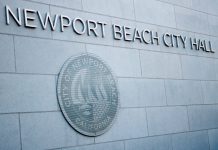
Four-time stroke survivor Mycle Brandy walked into Hoag Memorial Hospital Friday, just hours after completing his 11.5 mile walk along PCH earlier in the day.
“Hopefully we’re going to make enough noise now that people are going to start thinking about it,” Brandy said. “I hope someone’s going to say, ‘That bonehead has had some strokes and he’s walking across America, so maybe I should pay attention to what he’s saying.’”
What he’s saying is know the signs of stroke, take preventative measures and learn more about the facts of stroke.
And get off the couch.
Brandy is walking from San Diego to Seattle as part of his “Get Off the Couch” campaign to raise awareness for the National Stroke Association and the OC Stroke Association and encourage people to get off the couch. He also talks with current stroke patients and encourages them in their recovery.
Brandy, who turned 60 in February, walked across America last year for the same cause. His walk on Friday was actually in Marina del Ray, he had already passed through Newport Beach. He just took a ride to the hospital for the special visit.
He first came to Hoag in 1988 when he had his first stroke.
“There was no program in 1988,” said Dr. David Brown, Medical Director of Hoag‘s Stroke Program. “We’ve developed the entire stroke program in approximately the last eight years.”
The program has evolved and expanded quite a bit since it‘s inception, Brown said. Emergency professionals have now been trained to recognize the signs and stroke patients are brought directly to a comprehensive level stroke center, also called a stroke receiving center.
“That’s unique in the country,” Brown said. Elsewhere, most patients are brought to a primary type stroke center and then transferred to a more comprehensive stroke center, he added.
Brandy suffered from his first stroke after he crushed his foot on July 11, 1988. He was put in a walking cast and went back to his job as a construction worker the next day, he said.
Within a few days he was noticing tinnitus in the right ear, he heard a buzzing in his head and sound effects from a movie he was watching just didn’t sound right. So he called an ear doctor.
The doctor said he had an infection and gave him an antibiotic. Things got worse and Brandy visited another doctor, who gave him a different antibiotic but also suggested he get an MRI. Brandy decided not to go and put it off several more days. Since he wasn’t getting any better, he finally gave in and got an MRI.
“I came to the hospital here [Hoag], I think it was a Thursday, and Sunday morning the radiologist called me and said, ‘You’ve had a major stroke,’” Brandy recalled.
Brandy was flabbergasted. He was young, fit and in fairly good shape.
“The first reaction is often denial,” Brown said. “Now the only way we can overcome that is by education, teaching people about common stroke systems.”

An easy way to remember the signs of a stroke that Brown and the other doctors and nurses in the stroke unit teach is the FAST (Face, Arm, Speech, Time) method. If there is facial droop or an uneven smile, arm weakness or numbness, or slurred speech or difficulty speaking or understanding, then it’s time to call 911 and get to a hospital immediately.
“If any of those are abnormal, there’s an 80 percent chance they’re having a stroke,” Brown said.
Even kids should have FAST cards, said Deb Mastrolia, the Neuroscience Stroke Program Coordinator for Hoag’s Stroke Unit, so they can recognize the signs in mom, dad, grandparents or others. The more people that know, the better. Educating the public is key, she said.
Only 3 percent of patients across the nation get treatment for their stroke within the first three hours, Mastrolia said.
“Now, at Hoag, our average is 15 percent because we have an EMS system that’s on board … they get right in and we get them their treatment… But that means there’s still 85 percent that we still need to get to.”
That’s the whole reason he’s walking, Brandy said, to raise awareness so people know the signs and can get help in time.
Getting the word out is extremely important, both Brown and Brandy agreed. Teaching the public, not just those at risk, about FAST warning signs and how to prevent a stroke can be life-changing information.
Walking has helped a lot, Brandy said. It’s better to walk around the block than not to walk at all, Brandy said.
“I want people to see that you can’t sit and wait for death to come and get you. … (If you do) sit and wait … he’s going to come and get you pretty quick. So the whole idea is to get off your butt. … Get off the couch and walk,” Brandy said.
“The message has always been the same: You might not be able to walk across America, but I hope you’ll be able to walk across your piece of America.”




